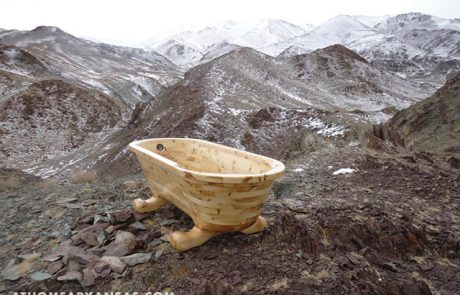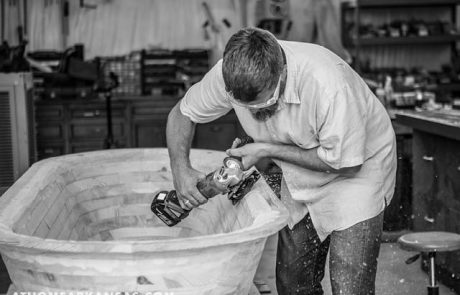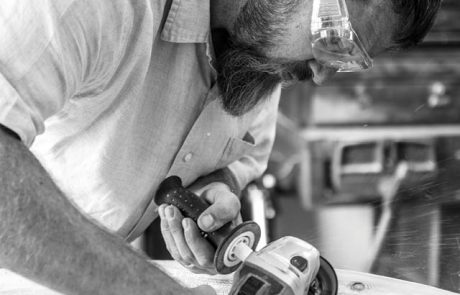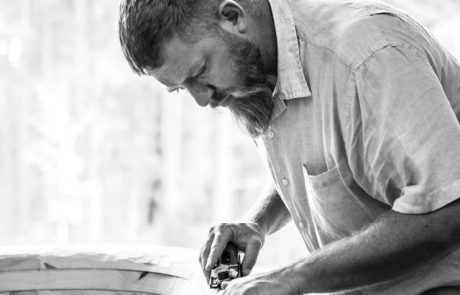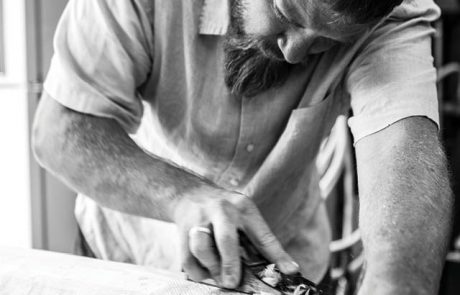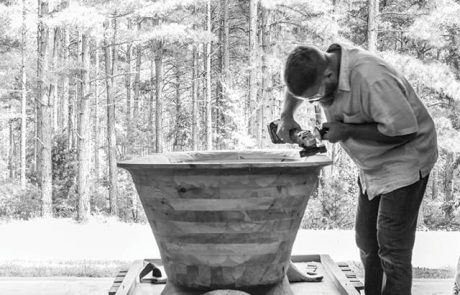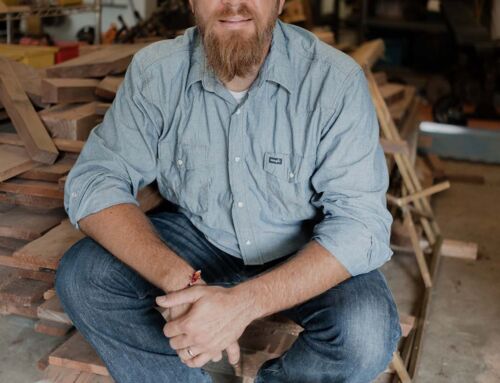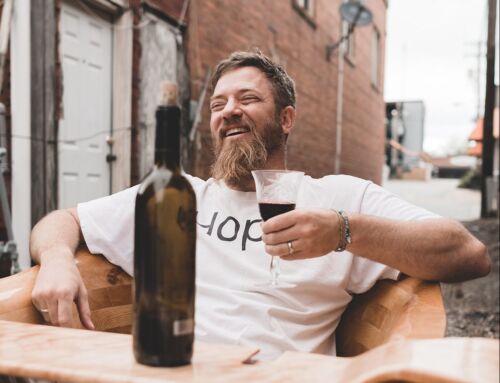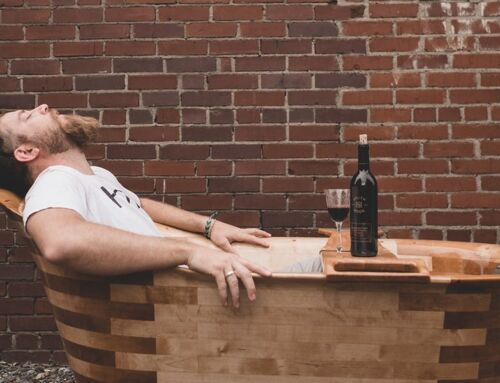You create bathtubs—beautiful, fully functional bathtubs—from wood. How does that work? It’s a process. From start to finish, it takes about two months to build each one of these. I begin by gluing up a board and cutting a circle with a bandsaw. Once I get a rough form, I carve it down with all of the curves. And then, the magic happens with a fiberglass cloth. This is what makes the wood usable and able to hold water. It’s also the longest part of the process. You form the fiberglass cloth around the tub and then a clear epoxy goes on it. It’s a similar process to creating a yacht or a kayak. So you actually aren’t sitting on the wood, but rather on the epoxy. It gives strength and prevents the tub from leaking.
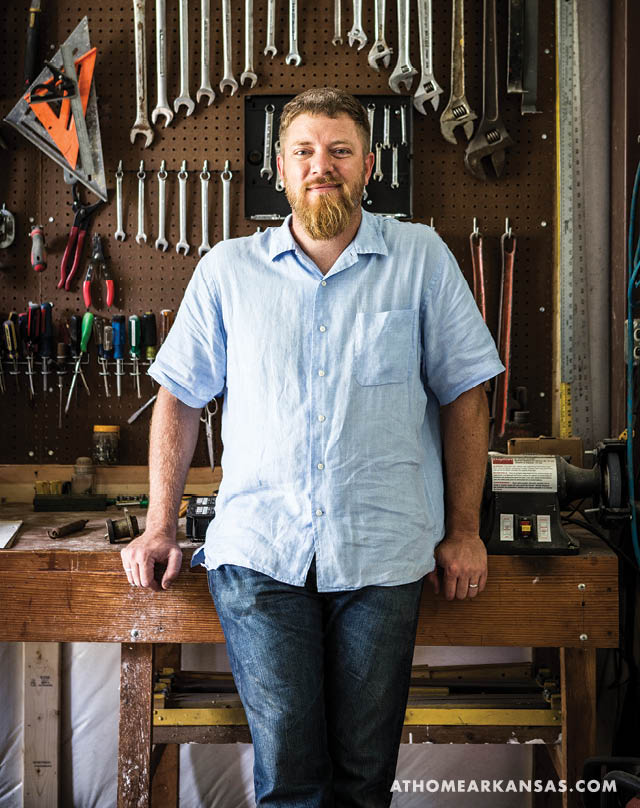
That’s a pretty amazing process. What first gave you the idea to do this? The first one I made was 13 years ago for a business competition called the Governor’s Cup [Donald W. Reynolds Governor’s Cup]. A buddy of mine and I were going to make a canoe but I was building a house and needed a bathtub, so I said let’s try that and enter it into this competition. So we did, and we won the technology award. That tub is still in my old house today. That’s part of why we were confident in doing this venture—because we had an almost 14-year beta test to see how it would stand up, and it’s doing great. We bathed all our kids in it and really abused it, and it’s still in great shape.
So, you didn’t immediately start your business, WaterWood? That’s right. I wanted to see how they would stand the test of time, and had some other life experiences. My wife and children and I ended up moving to Russia and then eventually to Mongolia. That’s where I saw the opportunity to be planted and start the business. We are currently splitting our time between the Mongolia workshop and my wife’s family farm in Searcy, Arkansas, where I also have a workshop.
What is the best way for Arkansans who are interested in seeing or purchasing a piece to learn more? We have a model set up at PC Hardware in Little Rock. You can go to the showroom to see the tub and feel the finish, and then we can customize options. We are actually making a square one from walnut now for a customer that saw the one on display and wanted a more modern design.
What’s next on your radar? We are currently hoping to expand our reach here in the States. We are looking at showrooms in Aspen, Atlanta, and North Carolina. Many people tell us these tubs are a great fit for mountain homes, lodges, or lake houses, so we are trying to make that accessible. We also build sinks based on the same concept and are looking to expand that market as well.
You create bathtubs—beautiful, fully functional bathtubs—from wood. How does that work? It’s a process. From start to finish, it takes about two months to build each one of these. I begin by gluing up a board and cutting a circle with a bandsaw. Once I get a rough form, I carve it down with all of the curves. And then, the magic happens with a fiberglass cloth. This is what makes the wood usable and able to hold water. It’s also the longest part of the process. You form the fiberglass cloth around the tub and then a clear epoxy goes on it. It’s a similar process to creating a yacht or a kayak. So you actually aren’t sitting on the wood, but rather on the epoxy. It gives strength and prevents the tub from leaking.

That’s a pretty amazing process. What first gave you the idea to do this? The first one I made was 13 years ago for a business competition called the Governor’s Cup [Donald W. Reynolds Governor’s Cup]. A buddy of mine and I were going to make a canoe but I was building a house and needed a bathtub, so I said let’s try that and enter it into this competition. So we did, and we won the technology award. That tub is still in my old house today. That’s part of why we were confident in doing this venture—because we had an almost 14-year beta test to see how it would stand up, and it’s doing great. We bathed all our kids in it and really abused it, and it’s still in great shape.
So, you didn’t immediately start your business, WaterWood? That’s right. I wanted to see how they would stand the test of time, and had some other life experiences. My wife and children and I ended up moving to Russia and then eventually to Mongolia. That’s where I saw the opportunity to be planted and start the business. We are currently splitting our time between the Mongolia workshop and my wife’s family farm in Searcy, Arkansas, where I also have a workshop.
What is the best way for Arkansans who are interested in seeing or purchasing a piece to learn more? We have a model set up at PC Hardware in Little Rock. You can go to the showroom to see the tub and feel the finish, and then we can customize options. We are actually making a square one from walnut now for a customer that saw the one on display and wanted a more modern design.
What’s next on your radar? We are currently hoping to expand our reach here in the States. We are looking at showrooms in Aspen, Atlanta, and North Carolina. Many people tell us these tubs are a great fit for mountain homes, lodges, or lake houses, so we are trying to make that accessible. We also build sinks based on the same concept and are looking to expand that market as well.
